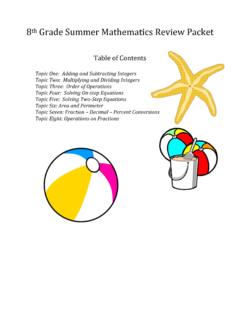Transcription of The Book of Fractions - La Citadelle, Ontario, Canada
1 Iulia & Teodoru Gugoiu The book of Fractions Copyright 2006 by La Citadelle Iulia & Teodoru Gugoiu The book of Fractions ISBN 0-9781703-0-X. 2006 by La Citadelle 4950 Albina Way, Unit 160. Mississauga, Ontario L4Z 4J6, Canada Edited by Rob Couvillon All rights reserved. No part of this book may be reproduced, in any form or by any means, without permission in writting from the publisher. Content Page Topic 5 Understanding Fractions 6 The graphical representation of a fraction 7 Reading or writing Fractions in words 8 Understanding the fraction notation 9 Understanding the mixed numbers 10 Reading and writing mixed numbers in words 11 Understanding mixed number notation 12 Understanding improper Fractions 13 Understanding improper fraction notation 14 The link between mixed numbers and improper Fractions 15 Conversion between mixed numbers and improper Fractions 16 Whole numbers, proper Fractions , improper Fractions and mixed numbers 17 Understanding the addition of like Fractions 18 Understanding the addition of like Fractions (II).
2 19 Adding proper and improper Fractions with like denominators 20 Adding mixed numbers with like denominators 21 Adding more than two like Fractions 22 Understanding equivalent Fractions 23 Finding equivalent Fractions 24 Simplifying Fractions 25 Checking Fractions for equivalence 26 Equations with Fractions 27 Adding Fractions with unlike denominators 28 Adding Fractions with unlike denominators using the LCD method 29 Understanding the subtraction of Fractions with like denominators 30 Subtracting Fractions with like denominators 31 Subtracting mixed numbers with like denominators 32 Subtracting Fractions with unlike denominators 33 Subtracting Fractions with unlike denominators using the LCD method 34 Order of operations (I). 35 Multiplying Fractions 36 More about multiplying Fractions 37 The order of operations (II). 38 Reciprocal of a fraction 39 Dividing Fractions 40 Division operators 41 Order of operations (III). 42 Order of operations (IV).
3 43 Raising Fractions to a power 44 Order of operations (V). 45 Converting Fractions to decimals 46 Converting decimals to Fractions 47 Order of operations (VI). 48 Time and Fractions 49 Canadian coins and Fractions 50 Fractions , ratio, percent, decimals, and proportions 51 Fractions and Number Line 52 Comparing Fractions 53 Solving equations by working backward method 54 Final Test 55 Answers Preface The book of Fractions " presents one of the primary concepts of middle and high school mathematics: the concept of Fractions . This book was developed as a workbook and reference useful to students, teachers, parents, or anyone else who needs to review or improve their understanding of the mathematical concept of Fractions . The structure of this book is very simple: it is organized as a collection of 50 quasi-independent worksheets and an answer key. Each worksheet contains: a short description of the concepts, notations, and conventions that constitute the topic of the worksheet.
4 Step-by-step examples (completely solved) demonstrating the techniques and skills the student should gain by the end of each worksheet; and an exhaustive test to be completed independently by the students. The concept of Fractions and the relations between Fractions and other types of numbers, like many abstract mathematical concepts, is not always easy to understand. Bearing this in mind, the authors of this book introduce each topic gradually, starting with the basic concepts and operations and progressing to the more difficult ones. Geared specifically to help the beginners, the first part of the book contains graphical representations of the Fractions . The techniques for solving both simple and complex equations implying Fractions are explained. As well, complete worksheets are provided, starting with very simple and basic equations and progressing to extremely complex equations requiring the application of a full range of operations with Fractions .
5 "The book of Fractions " also presents the link between Fractions and other related mathematical concepts, such as ratios, percentages, proportions, and the application of Fractions to real life concepts like time and money. The importance of the concept of Fractions comes both from its link to natural numbers and its link to more complex mathematical concepts, like rational numbers. As such, the concept of Fractions is a milestone in the mathematical evolution of a student, being a concept that is simultaneously concrete (as a part of a whole) and abstract (as a set of two numbers and a hidden division operation). The concept of equivalent Fractions is an essential part of understanding Fractions , and a full range of techniques is presented, starting with graphical representations (suitable for students in lower grades) and progressing to advanced uses, like the factor tree method of finding the LCD. The order of operations is also presented, gradually, after each main operation with Fractions : addition, subtraction, multiplication, and division; using multi-term expressions; expressions containing grouping symbols of one or more levels; and more complex operations with Fractions , like powers with positive and negative exponents.
6 Single-step questions (requiring a basic knowledge and understanding of the topic presented in the worksheets). and multi-step questions (requiring a complete understanding of all of the concepts presented in the worksheets to that point) are presented throughout the entire book . Combining more than 15 years of academic studies and 30 years of teaching experience, the authors of this book wrote it with the intention of sharing their knowledge, experience and teaching strategies with all the partners involved in the educational process. Iulia & Teodoru Gugoiu, Toronto, 2006. The book of Fractions Iulia & Teodoru Gugoiu Understanding Fractions 1. A fraction represents a part of a whole. 2. The corresponding fraction is: Example 1. 3 The numerator represents how many parts are taken. Fraction line or division bar The whole is divided into four equal parts. Three part are taken (considered). 4 The denominator represents the number of equal parts into which the whole is divided.
7 F01. Write the fraction that represents the part of the object that has been shaded: a) b) c) d) e). f) g) h) i) j). k) l) m) n) o). p) q) r) s) t). 0 1. u) v) w) x) y). La Citadelle 5 The book of Fractions Iulia & Teodoru Gugoiu The graphical representation of a fraction 1. A fraction represents a part of a whole. 2. A corresponding graphical representation Example 1. (diagram) is: 3 The numerator represents how many parts are taken. Fraction line or division bar The whole is divided into four equal parts. 4 The denominator represents the number of equal parts into which the whole is divided. Three part are taken (considered). F02. Draw a diagram to show each fraction (use the images on the bottom of this page): 1 1 1 2 1 2 0. a) b) c) d) e) f) g). 2 3 4 5 6 4 3. 2 5 2 9 1 3 4. h) i) j) k) l) m) n). 9 6 12 10 1 3 6. 3 4 5 4 2 8 5. o) p) q) r) s) t) u). 4 12 10 9 4 12 13. 5 1 7 37 11. v) w) x) y) z). 16 8 49 100 18. 0 1. La Citadelle 6 The book of Fractions Iulia & Teodoru Gugoiu Reading or writing Fractions in words 1.
8 You can use words to refer to a part of a whole. Example 1. So one whole has: 3. 2 halves 7 sevenths 12 twelfths 100 hundredths The fraction 3 thirds 8 eighths 13 thirteenths 1000 thousandths 4. 4 quarters 9 ninths 20 twentieths 1000000 millionths can be written in words as: 5 fifths 10 tenths 30 thirtieths 1000000000 billionths 6 sixths 11 elevenths 50 fiftieths three quarters F03. Write the following Fractions in words: 2 3 1 1 3 3 1. a) b) c) d) e) f) g). 3 100 10 2 7 20 1000. 4 8 8 8 5 5 7. h) i) j) k) l) m) n). 5 30 13 9 6 8 1000. 3 2 21 6 7 11 11. o) p) q) r) s) t) u). 50 5 100 12 11 50 1000000. 2 7 11 2 9. v) w) x) y) z). 9 10 12 50 1000000000. F04. Find the fraction written in words: a) one third b) one half c) one sixth d) two fifths e) four sevenths f) seven eighths g) eleven fiftieths h) seven twentieths i) five twelfths j) eight ninths k) six tenths l) nine thousandths m) fifteen millionths n) eight sixths o) three fiftieths p) eleven billionths q) twenty-three hundredths r) seven thirteenths s) eleven twelfths t) three billionths u) thirteen thirtieths v) one fifth w) one eleventh x) eight ninths y) six tenths z) six twelfths La Citadelle 7 The book of Fractions Iulia & Teodoru Gugoiu Understanding the fraction notation 1.
9 A fraction also represents a divident Example 1. The dividend (numerator) is 3. quotient of two quantities: divisor 3 The divisor (denominator) is 4. 4 The fraction in words is three quarters. 2. The dividend (numerator) represents how many parts are taken. A possible graphical representation of this fraction is: The divisor (denominator) represents the number of equal parts into which the whole is divided. F05. Fill out the following table: Fraction Numerator Denominator Graphical representation (Dividend) (Divisor) The fraction written in words 2. a) 3 2 3 two thirds b) 1 4. c) three fifths d). e) 3. f) 5 2. 2. g) 5. 3. h) .. quarters i) five .. 3. j). k) 4 .. sixths l) 5 three .. La Citadelle 8 The book of Fractions Iulia & Teodoru Gugoiu Understanding the mixed numbers 1. A mixed number is an addition of wholes and a part of a whole. fraction part Example 1. The numerator indicates how many parts whole-number part 3 are taken from the last whole.
10 (the number of complete wholes). 1 The denominator represents the number There are one complete whole and three quarters of the second whole 4 of equal parts into which the whole is divided. F06. Find the mixed number that corresponds to the shaded region: a) b) c). d) e) f). g) h) i). j) k) l). m) n) o). p) q) r). s) t) u). v) w) 0 1 2 x) 0 1 2 3. F07. Find a possible graphical representation of each mixed number: 2 1 5 4 3 5 5. a) 1 b) 3 c) 2 d) 3 e) 3 f) 1 g) 4. 3 2 6 5 7 8 11. 1 2 2 2 3 6 3. h) 3 i) 2 j) 2 k) 2 l) 1 m) 6 n) 1. 6 9 5 10 20 10 6. 5 7 7 4 1 5 7. o) 3 p) 1 q) 2 r) 2 s) 5 t) 2 u) 3. 8 16 10 5 1 6 10. 1 1 7 3 3. v) 1 w) 5 x) 3 y) 2 z) 6. 6 2 9 8 4. La Citadelle 9 The book of Fractions Iulia & Teodoru Gugoiu Reading and writing mixed numbers in words 1. You can use words to refer to a part of a whole. Example 1. So one whole has: 3. 2 halves 7 sevenths 12 twelfths 100 hundredths The fraction 2. 3 thirds 8 eighths 13 thirteenths 1000 thousandths 4.


